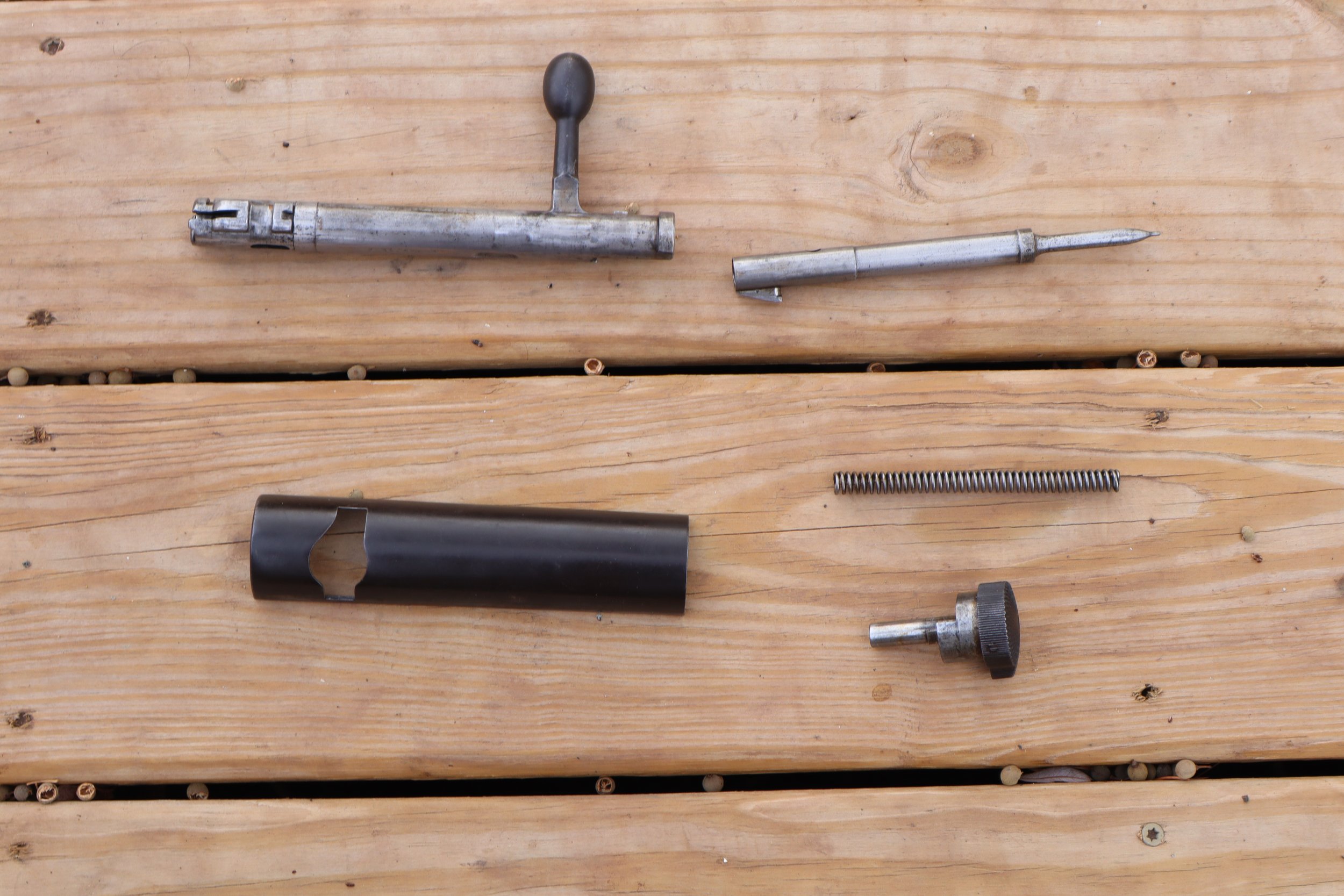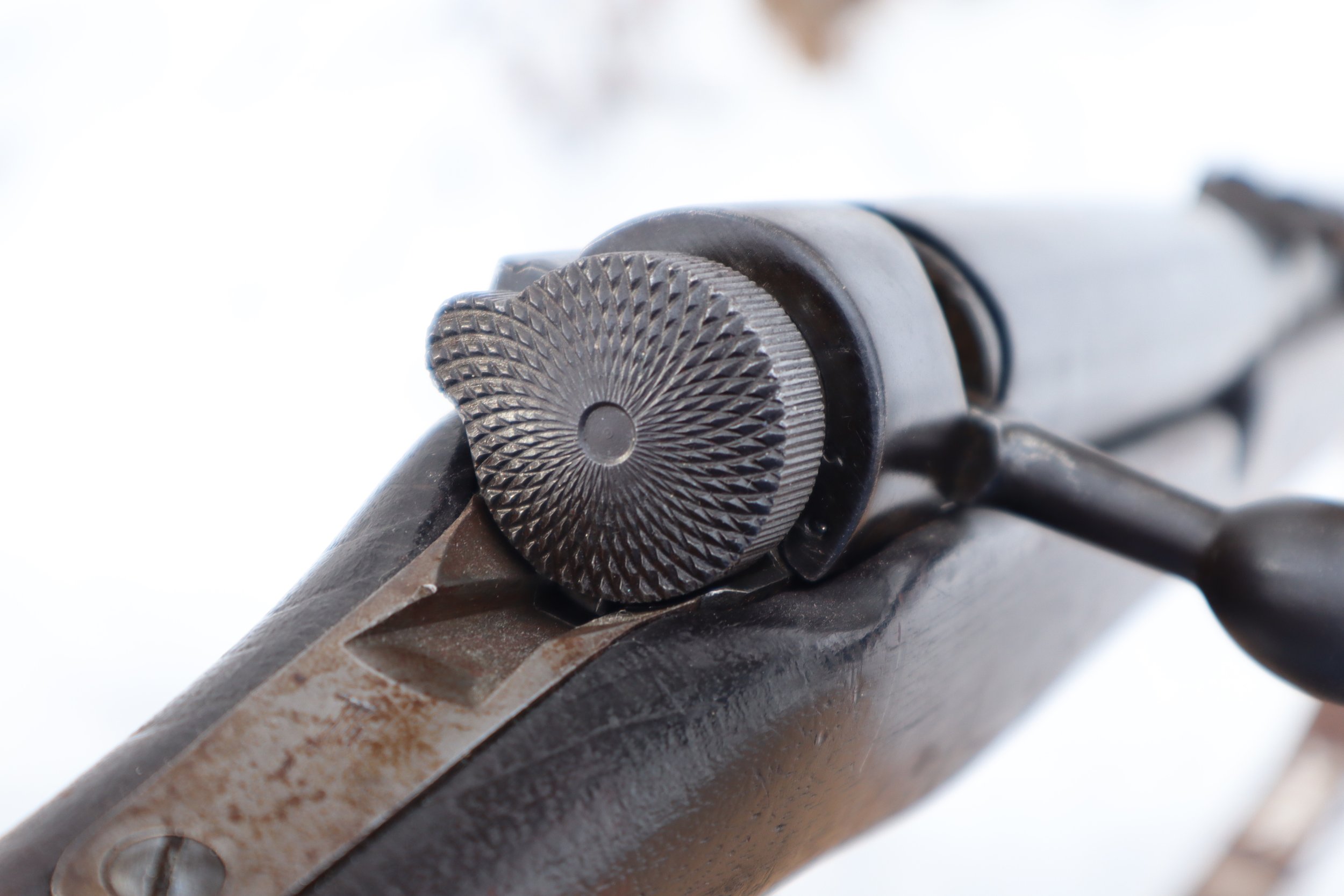Type 38 Arisaka
Problems with Japan’s first smokeless powder rifle prompted a redesign of the mechanism, leading to one of the strongest and simplest rifles ever produced, which would serve the Empire for almost half a century.
The History
The Empire of Japan had been a latecomer to the industrial revolution, with a centuries-long isolation under the Tokugawa Shogunate having been brought to an end only in 1868 after an American incursion prompted the restoration of the Emperor as sole sovereign. Despite this, the Meji Emperor had overseen a period of rapid modernization intended to spare Japan the fate of other Asian empires, which were finding themselves consumed by the European Imperial states. As a result, the Imperial Japanese Army was a premier fighting force by the turn of the 20th century, with its troops joining in the suppression of the Boxer Rebellion as one of the Eight Nation Alliance.
The rear sight of the Type 38, in its battlesight position. Later production rifles would replace the v-notch with an aperture
In 1897, the Emperor’s forces began to receive their new Arisaka Type 30 rifles, which were the first smokeless powder design adopted into Japanese service. Although they would serve well in the Boxer Rebellion and elsewhere, the design was found to be both complex and somewhat fragile, prompting an enterprising officer to redesign the rifle with a goal to eliminate these flaws. Kijiro Nambu’s new rifle was thus introduced in 1905, designated the Type 38, which, despite retaining the Arisaka name in popular memory, was now an original design based on the German Mauser pattern.
The rear sight in its elevated position. Note the additional lower notch
The new Type 38 was quickly joined by a matching carbine, as well as a specialized cavalry model equipped with a folding bayonet, designated the Type 44. The new rifle began to be fielded in 1906, too late for service in the war against Russia in 1905, but it quickly proved to be superior to both the Type 30 and the Navy’s interim Type 35 rifles due to its greatly simplified action. In the following years, the Type 38 would supplant the Type 30 in Japanese service, and by the time that the Great War commenced in 1914 had acheived full standardization.
The front sight of the Type 38, which in its earlier form lacked a protector
Japan’s contribution to the First World War was limited, with the only significant operation commenced by the Imperial Army being the Siege of Tsingtao in China, where the German concession there was captured by the IJA and their British allies. Following that, Japanese participation was mostly limited to naval actions, although that did not mean that the Type 38 would sit out the remainder of the conflict.
Large quantities of Japanese Type 30 and Type 38 rifles were sold or given to the Russian Empire during the course of the Great War, and indeed were so common that when an autoloading rifle was developed during the war the light recoiling 6.5mm Japanese cartridge would be selected for its chambering. Type 38s would see service in the subsequent Russian Civil War as well, both in the hands of the White and Red Armies as well as the IJA as they intervened in Siberia.
The mechanism of the Type 38, as seen with the dust cover removed. Note the Mauser-type long claw extractor, as well as the Imperial Chrysanthemum and the designation 三八式 (San-Hachi Shiki, Three-Eight Type)
Over the interwar period a program was launched to upgrade and replace the Type 38 with a more modern short rifle, chambered in a harder hitting 7.7mm cartridge, which would culminate in 1939 with the introduction of the Type 99. Despite this, the Empire had already been at war in China for three years, and in although production of the Type 38 was slowed and eventually mostly ceased by the time of the Attack on Pearl Harbor both the rifles and their ammunition remained very common in Japanese service throughout the ensuing Pacific and East Asian War.
The drainage cut on the Type 38 is an interesting feature well suited to fighting in wet environments, allowing the rifle to be easily drained if submerged in water
The Type 38 would finally be retired at the end of the Second World War with the surrender of Japan, although a vast number would end up amongst the detritus of war that inundated the region, turning up in China, Korea and Vietnam among others in the ensuing years of Cold War conflicts, and to this day occasionally appear in the hands of irregular forces in the Asia-Pacific region.
The butt of the Type 38, displaying the reddish oil finish of earlier production Arisakas, along with the distinctive two piece stock of the entire series.
The Design
The Type 38 is a full length infantry rifle, and uses a rotating bolt action developed by Kijiro Nambu as an update to the original Type 30 designed by Nariakira Arisaka. The result is a brutally simple mechanism, using a Mauser type long claw extractor and a partial cock-on-close action. The bolt itself consists of only six components (bolt body, extractor, extractor collar, firing pin, spring, safety), and can be fully disassembled with one motion of the hand and no additional tools.
The 6.5mm Japanese cartridge allows for very low recoil, as well as a fairly quiet rifle with little muzzle flash, thus making it difficult for enemies to locate the shooter. Its integral dust cover is another ingenious feature, ensuring that the rifle remains functional in even the most adverse environments.
The bolt disassembled, displaying the extremly simple mechanism designed by Kijiro Nambu
This Example
The example in the collection is a relatively early model produced by the Koishikawa, likely circa 1921 (records for these early rifles are difficult to trace). It is in very good overall condition, including its interact Imperial Chrysanthemum. It wears a reproduction sling, and although it is missing its dust cover it is wearing one borrowed from another Arisaka in the collection for the purposes for photography.
The large safety of the Type 38 is intended to be operated with the palm of the hand, with the protruding segment intended to provide a visual indicator of its status
Opinions
The Type 38 is a fine rifle, with a smooth and reliable action. The author has used it to take deer in Northern Wisconsin, finding the aforementioned qualities of low noise levels and recoil beneficial. As a military rifle, it compares very favorably with those of the other powers of the Great War, although it shows its age in the Second World War, in large part due to its ungainly length.
A Japanese machine gun team in Sashi, China. The man on the left is holding a Type 38 infantry rifle
Observed Values and Frequency
Updated: February, 2024
AVERAGE VALUE (USD): $300-$600
FREQUENCY: Common
COLLECTOR’S NOTES: Collectors place a high value on the intact Chrysanthemum seal, as well as the presence of accoutrements such as the dust cover and cleaning rod.










